



1Theater Entrances


There were three entrances to the theater, which were all based on rank. The entrance for ordinary members of the public was at the center of the building and is called the “mouse entrance” (nezumi kido). It is said that to ensure that all guests paid to view the show, the opening was designed to be so narrow and low that only by leaning forward could guests enter the building and then only one by one, hence the name.
Two other entrances are found at the front of the building. The goyo kido (VIP entrance) is on the right side. The okido (large entrance) is on the left-hand side and was for holders of expensive tickets.
2Tickets and Shoes
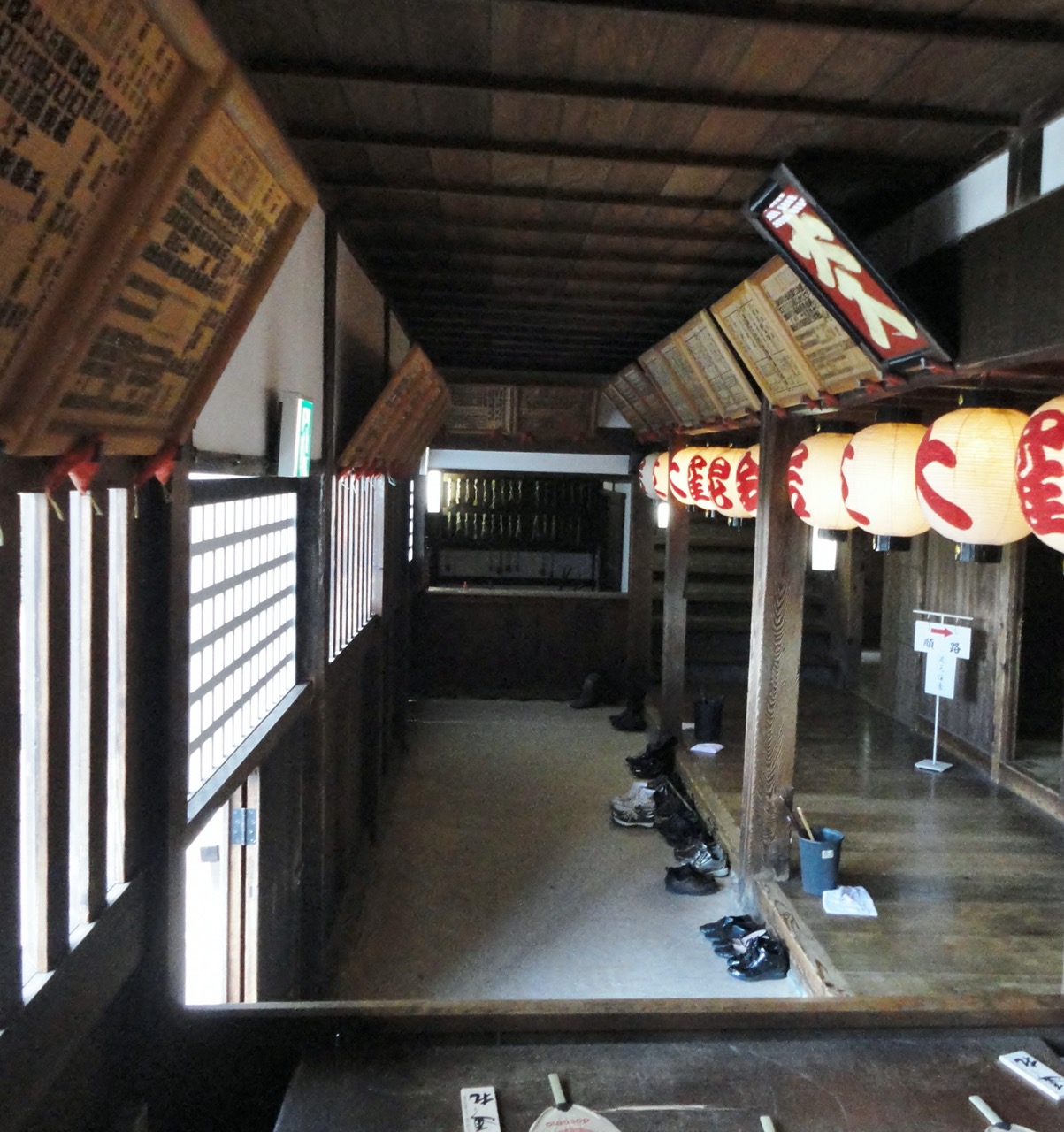

After entering the kido entrance, there is a large earthen floor space. On the right there is a ticket gate, where one can purchase tickets. On both sides of the entrance space, there are spaces for storing shoes. After stepping up into the inner entrance (uchi kido), the footwear is hung up by the attendant and one receives a docket for them. When you receive the numbered ticket for your shoes, you are free to go to your seat.
3Toya and Agemaku

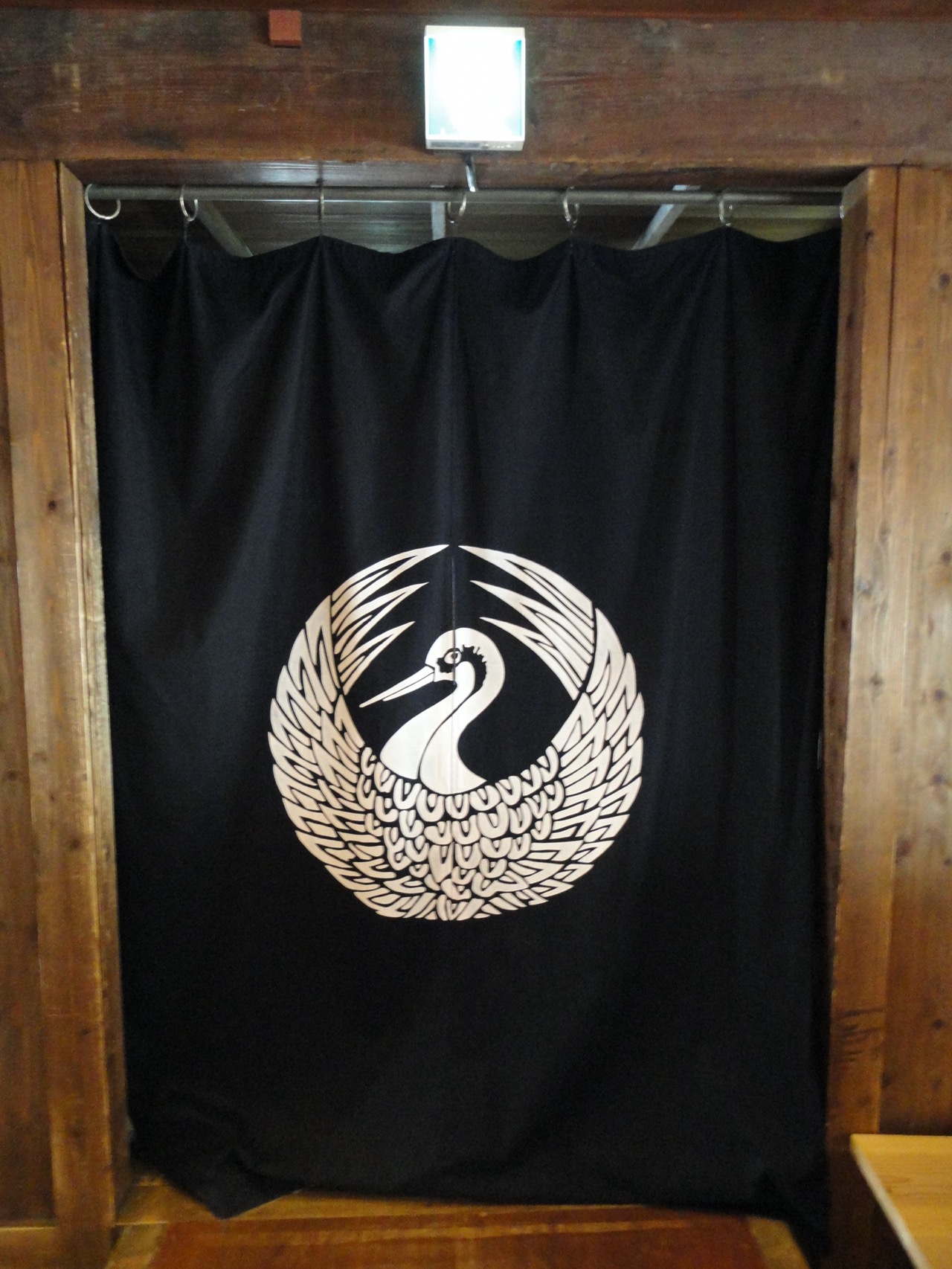
The toya is a backstage space. It is located at the end of the hanamichi, which is a long narrow additional part of the stage in Japanese kabuki theater, connecting the stage to the back of the theater. Actors enter the toya from the underground space behind the stage and wait for their turns to come out onto the hanamichi. The toya is also used as an exit from the stage, so it is a very important space.
In front of the toya room, a curtain, called agemaku, displays the crest of the theater. The rings attached to the curtain make a distinctive sound when the curtain is opened and closed, creating a dramatic effect.
4Hiraba, Ayumi, and Masuseki

The hiraba (lit. “level area”) is the center part of the first-floor seating. The seats are labeled from right to left in the traditional Japanese style, using the hiragana letters i, ro, ha, ni, ho, he, to, chi, ri, nu... From the stage to the back of the theater, the seats are numbered in Chinese character numbers from 1 to 11. The seats in this center part of the theater are called masuseki (“squared box seats”) where up to five people can sit. The flexible seating arrangement allows members of the audience to move and turn around freely so that they may see the main stage, the hanamichi, or the flying players. A gentle slope upwards away from the stage ensures that the spectators can see well.
There are also boxes (sajiki) on both sides of the theater on the first and second level.
In addition there are five walking planks (ayumi) 15 cm in width that stretch across the hiraba seating area. These planks facilitate access to the seating areas.
The front row seating area is called kaburitsuki, which literally means “to bite into.” Here the audience can enjoy the kabuki at its most intense. Yet another name for the front row seats is the amaochi (“rain falls”), because when a lot of water is used in the play the audience will get splashed upon.
Note that there may be slight changes in the names and numbers of the seats in the Shikoku Konpira Kabuki Oshibai performances.
5Seating: Deseki and Okuba


The box seats, which are slightly raised, are called deseki and demago seats and are to the left and the right of the hiraba central seating area. In the past, these seats were reserved for patrons and frequent visitors to the theater. Currently, the seats on the west side are called nishi demago seats, and the seats on the east side are called higashi deseki seats.
The okuba is a space at the back of the main hanamichi (hon hanamichi) and the secondary hanamichi (kari hanamichi.) The okuba was historically a surveillance area marked off by a low fence. Attendants collected additional fees here for the seating areas, separately from the fee paid at the entrance. The attendants also observed from here if the members of the audience sat in their correct seats.
Note that there may be slight changes in the names and numbers of the seats in the Shikoku Konpira Kabuki Oshibai performances.
6Hanamichi and Kari Hanamichi

The hanamichi (lit. “flower path”) is an additional part of the stage in a Japanese kabuki theater. It is a long, raised narrow walkway that runs to the left of the center of the main seating area from the back of the theater, through the audience, to connect with the main stage. The walkway can be used for a variety of scenes, providing settings such as a road, the aisle of a castle, or even the ocean. When the actors use this walkway they move right in the midst of the audience, adding great drama and excitement to the play. The actors appear from behind the agemaku curtain. This opens with a clattering sound made by wooden blocks to alert the audience that the actors will appear, further building up the dramatic tension.
The walkway is 1.3 meters in width and 14 meters in length. It leads to the small waiting space called the toya, where the actors enter and exit. In addition to being used for characters’ entrances and exits, the hanamichi is also used for scenes taking place apart from the main action. It is an integral part of the kabuki stage.
A kari hanamichi (secondary hanamichi) runs along the right side of the theater from the back of the theater to the stage. It is 0.8 meters in width, 14 meters in length. This sub-hanamichi was originally created in the Edo period as a pathway to the audience seats. But the players of old realized its potential dramatic effect and began using it in the kabuki plays as a secondary hanamichi. The Kanamaruza uses both hanamichi so the audience can enjoy the kabuki at its best.
7Karaido and Suppon
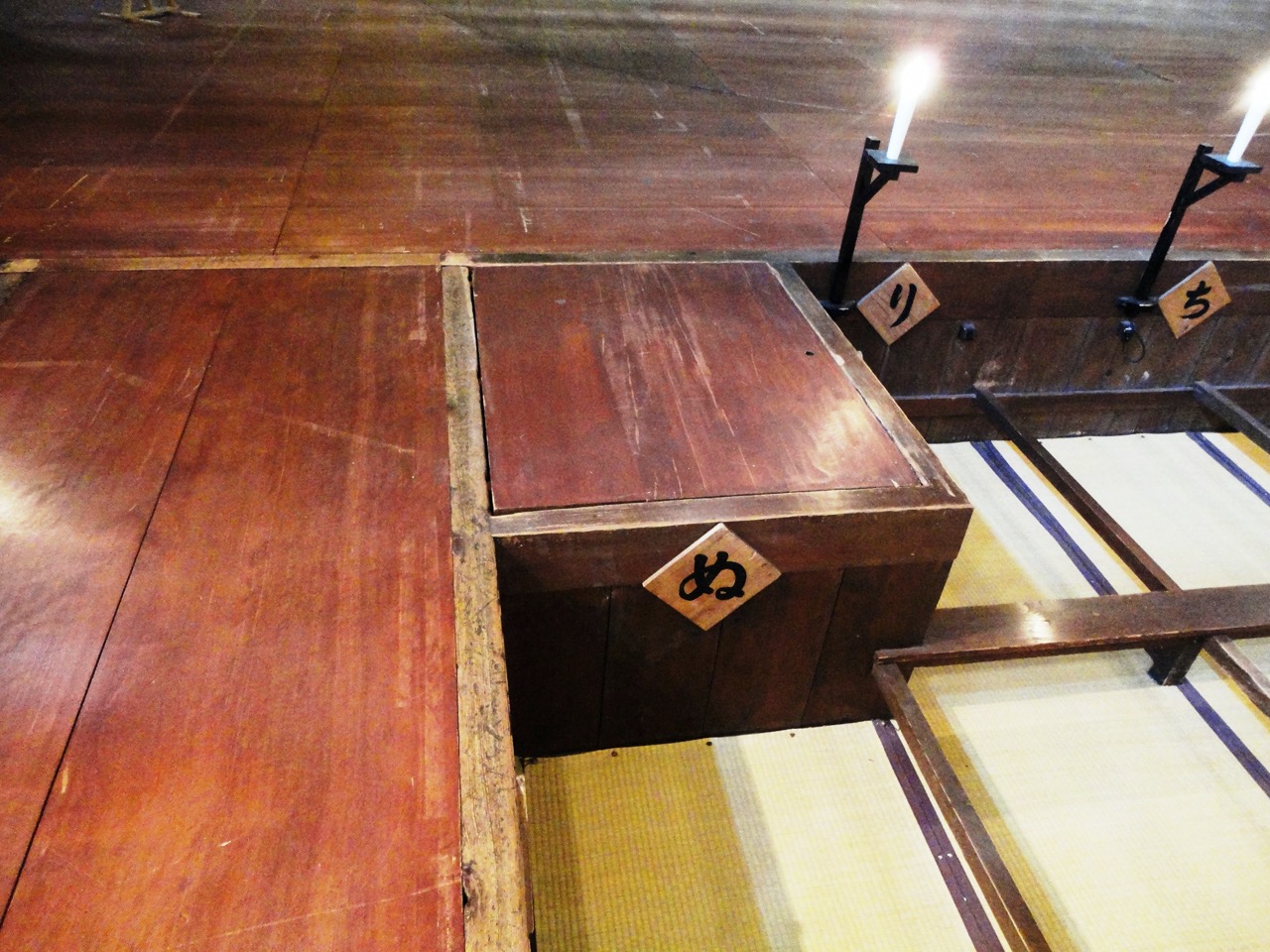

The karaido (lit. “dry well”) is a square opening (closed over when not in use), located at the intersection where the main stage joins the hanamichi. It disappeared from the modern theater, but it is said that it was used in the Kamigata (Kyoto Osaka) area of Japan in the Edo period. It is connected to the underground area (naraku) and has many uses. In addition to the actors’ entrances and exits and quick costume changes, it can also function as a well or a pond. The Kanamaruza is the only theater that has retained this function to the present day.
The suppon hole is a “trap door” on the hanamichi, close to the stage. It is 0.8 meters long and 0.6 meters wide. In the Kanamaruza, the trap door is moved up and down by men underneath. The name suppon (“turtle”) comes from the fact that when the kabuki actor sticks out his head from underneath the stage, it looks like a turtle’s head craning. This door is mainly used to introduce phantoms, ghosts, and goblins.
8Seri and Mawari Butai


The revolving stage (mawari butai) is a circular platform 7.3 meters in diameter, in the center of the stage. A circle is cut from the center of the flooring, and there is a mechanism underneath it to turn the stage. The revolving stage can turn 360 degrees, and was first developed for Kabuki theaters. It is used for scene changes and other effects. Modern theaters use electricity to rotate the stage, but at Kanamaruza it is still people powered.
Beneath the revolving stage is a space called naraku, with four poles and thirty-six stone footholds arranged on the earthen floor. Pushing the poles, the movers move from one foothold to the next to rotate the central stage. Between the stage above and its frame are wooden rollers (or roller bearings). There are twenty-six sets, each with three rollers inside, and these are used to facilitate the rotating of the stage. In 2010, the wooden rollers were recognized as a Mechanical Engineering Heritage by the Japan Society of Mechanical Engineers.
Within the revolving stage, there is a cutout lift or another trap door (seri) (0.9 m x 1.9 m). This is a rectangular platform that operates as a lift, descending into the naraku below and rising again to the stage level. The use of the seri is yet another way to add dramatic tension to the play. This too is human-powered.
9Choboyuka and Hayashiba

The hayashiba is the place where the accompanying music of the kabuki is performed. It is generally located, as here, in a small space just off-stage behind a barred window, and the players are only barely visible to the audience. At Kanamaruza, the hayashiba is on the left side of the stage. Here the performers sing the nagauta, tokiwazu, and kiyomoto and perform music to heighten the dramatic effects of the drama.
The nagauta, literally “long song,” which dates from the Edo period, is a kind of traditional song that accompanies the performance. It was influenced by Noh style of singing, and the shamisen and drums (taiko) are played to accompany the songs. Depending on the type of play there may also be drums of varying sizes, different types of flutes, and other instruments, as well as a myriad of devices for creating sound effects.
The choboyuka is the area on the upper level on each side of the stage where the narrators (tayu) sing the accompanying songs.
10Naraku (Abyss or Hell)
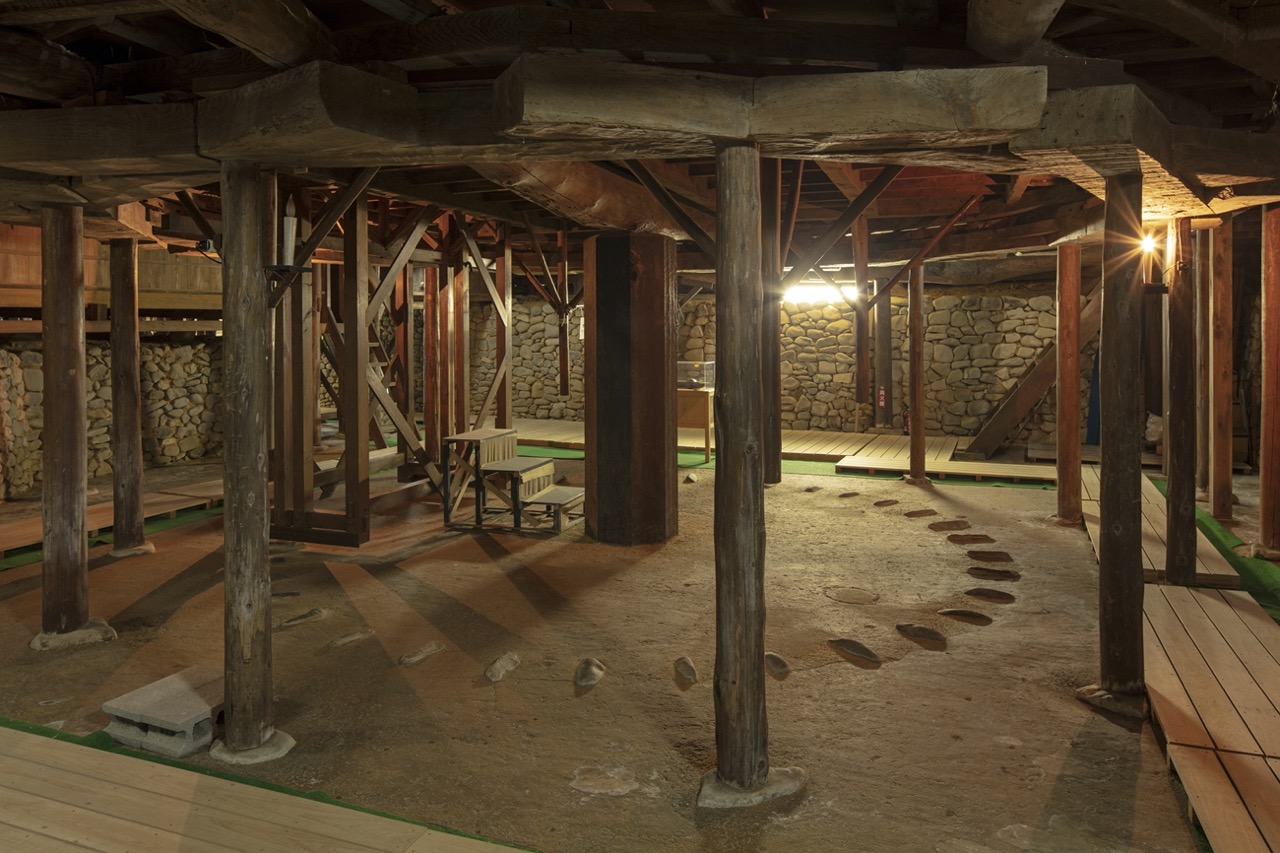
The naraku is a generic term used to refer to the area under the stage and the hanamichi. It takes its name from the Buddhist word for hell, naraku. This name relates to the fact that this dark and gloomy underground space is reminiscent of a Buddhist hell.
It is also the place from which the various technical operations that are part of the kabuki are performed, such as opening the lift on the circular stage, the dry well, and the suppon, and rotating the circular stage. Unlike other contemporary kabuki theaters, everything at Kanamaruza is human-powered.
The surrounding walls are made of stone with a depth of 2.5 meters, and the ground is an earthen floor. The naraku is located underground, so actors can move from the green room to the toya without being seen by audience.
11Gakuya

The gakuya is on two floors. It is here that the actors and staff prepare for the performance, not unlike the Green Room of a Western theater. It includes the actors’ changing rooms, the musicians’ (hayashi kata) resting rooms, and a place for the hairdresser (tokoyama) to prepare the elaborate hairstyles of the actors. The gakuya in this theater still retains the atmosphere of the Edo period. However because actors today are much taller than they were in earlier eras, it is difficult for them to descend the stairs in full costume. Thus only the first floor is now in regular use.
12Second Floor

The second floor offers a commanding view of the hanamichi and the stage. It contains boxes on both sides and a section of seating at the back. The latter is called muko sajiki (lit. “the boxes beyond”). This area is divided into three tiers, or sections: front, middle, and rear. These sections are known by the names, “front boat” (maebune), “middle boat” (nakabune), and “rear boat” (atobune).
Historically, there were general admission seats on the first floor, in the section called hinode next to the hanamichi on the side away from the stage. This seating area is not divided into sections. The name hinode (“sunrise”) relates to its location, on the east side. Hinode means “rising sun.”
For performances of Shikoku Konpira Kabuki Oshibai, the names of the seating sections may be slightly different.
13Budodana and Kakesuji

A renovation that took place in 2003 at Kanamaruza revealed the grapevine trellis (budodana) and a mechanism allowing actors to fly into the air (kakesuji). In the historic Kanamaruza, the grapevine trellis was not just above the stage itself, but also extended over the audience seats.
The grapevine trellis is a like a net ceiling, made of five hundred long stalks of bamboo and bound in a grid pattern with straw rope. This ceiling provides a perch from which paper snow or cherry blossoms can be scattered over the audience. Sometimes, in darkness, tiny electric lights are flown to suggest fireflies.
The kakesuji is the mechanism that allows actors to fly into the air. It is about 17 meters long and 60 cm wide, suspended five meters above the hanamichi, extending from the stage to the ceiling above the balcony seats. The kakesuji in the Kanamaruza is exceedingly rare, one of only a very few that survive from its time. As such it is also an important object for research into theatrical history.
In the past, straw ropes were used, but in more modern times wires and electric motors are used instead for safety reasons. The spectacle of an actor rising into the air never fails to excite and delight the audience.
14Akari Mado and Kaomise Chochin


In the Kanamaruza, there are windows and shutters (akari mado) behind and above the balcony seats on the east and west sides that can be opened and closed to adjust the level of brightness in the theater. There are both paper shutters and wooden shutters, which can be arranged in different ways to achieve different lighting styles. Using the paper lighting one can invoke natural daylight. When required by the performance, the wooden shutters can be manually closed all at once, plunging the theater into darkness.
The kaomise chochin are lanterns with the family crests of the actors written on them. They are hung above the audience seats. During a performance, these lanterns indicate which performers are playing and the ranks that they hold. When audience members enter the theater, they are sure to be amazed by these lanterns, because of their large and impressive size and striking appearance (1.2 m tall x 45 cm wide).
15Yagura

The yagura is a small wooden and fenced lookout platform high on the outside wall of the theater. During the performance period, drums are beaten every morning, and banners are hung from the railing displaying the crest of the theatrical producers or the current company. In the heyday of the Konpira Kabuki Oshibai, the round crane of the Saeki family crest (called Saeki zuru no maru) appeared on the banner.
The image of the Saeki zuru no maru is taken from a depiction of a theater painted on a Genroku-period screen depicting the Konpira Festival, in the collection of the Konpira Shrine Treasury.
Built in 1835, Kanamaruza is Japan’s oldest surviving complete kabuki theater. Konpira Daigongen (now known as Konpira san and Konpira Shrine) became a site of national pilgrimage in the middle of the Edo period (eighteenth century), drawing visitors to Kotohira from all over Japan. Kabuki and other forms of entertainment had been provided for these pilgrims several times a year in a temporary playhouse. As the town developed and expanded at the base of the shrine, Konpira Oshibai was constructed as a permanent kabuki theater to entertain the pilgrims. Renamed Kanamaruza around 1900, it has been known affectionately by that name ever since.
Kanamaruza was registered as an Important Cultural Property in 1970. Over a four-year period beginning in 1972, it was dismantled and reconstructed in its present location. In 2003, restoration work was begun and the theater was restored to its original Edo-period state.
In 1984, the theater attracted the attention of the professional kabuki world. Three famous actors, Nakamura Kichiemon II, Sawamura Tojuro II, and Nakamura Kankuro V, visited Kanamaruza to produce a TV program about it, which made it well known throughout Japan. They were fascinated by the theater’s unique atmosphere and traditional design, and thus the idea to hold regular performances there was born. In late June 1985, a kabuki troupe led by Kichiemon staged the play Saikai Zakura Misome no Kiyomizu (Reunion Among the Cherry Blossoms After the First Meeting at Kiyomizu) and the dance drama Niwaka Jishi (Spirited Lion) at the Kanamaruza.
Since 1985, annual kabuki performances called the Shikoku Konpira Kabuki Oshibai have been held in the month of April or May, an event that marks the arrival of spring to Shikoku island. First-rank kabuki actors come to perform, and the audience can relish kabuki in the compact size of theater for which it was originally designed, allowing close proximity to the stage and hanamachi, and a marvelous sense of intimacy with the players.
1st floor

- 1Theater Entrances
- 2Tickets and Shoes
- 3Toya and Agemaku
- 4Hiraba, Ayumi, and Masuseki
- 5Seating: Deseki and Okuba
- 6Hanamichi and Kari Hanamichi
- 7Karaido and Suppon
- 8Seri and Mawari Butai
- 9Choboyuka and Hayashiba
- 10Naraku (Abyss or Hell)
- 11Gakuya
Second floor
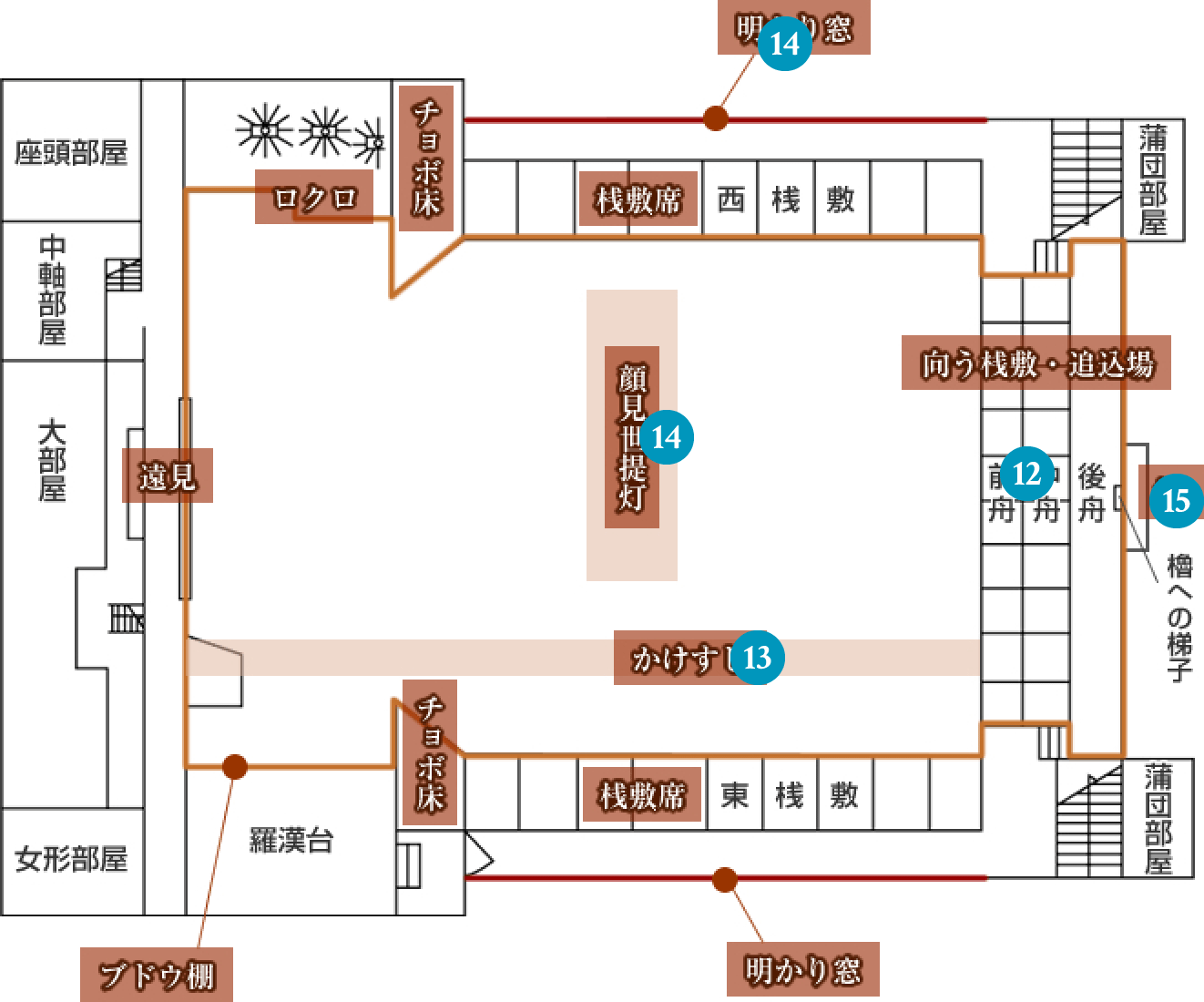
Kabuki
Kabuki is a classical Japanese drama that involves dance and music. It dates to 1603 and developed fully in the Genroku period (1688–1704 ). Kabuki was originally performed by women, but they were banned from appearing on the stage in 1629, and since then all the roles have been played by male actors. The female role specialists are called onnagata.
Kabuki was the most popular performing art in the Edo period, although the Tokugawa government periodically attempted to ban in order to keep it under control. It continued to attract audiences in the Meiji period as well. Kabuki declined for a while after the Second World War, but these days it is the most popular of the traditional styles of Japanese drama, and its stars are household names who often appear on TV, and also in movies and advertisements. Bando Tamasaburo is one such famous onnagata. Kabuki has greatly influenced Japanese culture and also appears in various forms of pop culture, such as anime. Indeed, it is seen by some as one of the most significant sources of pop culture in Japan.
There are several types of plays: history plays, contemporary plays, and dance pieces. History plays (jidaimono) often depicted real events in Japanese history but changed the setting to another period to avoid the censorship of the Tokugawa government. Contemporary or domestic stories (sewamono) often feature family drama and romance, and some of the most famous are about love suicides. In addition, there are some delightful dance pieces.
Kabuki is famous for the stylization of its drama and for the elaborate costumes and makeup of the actors. Kabuki theaters are also celebrated for their many unique features, such as the hanamichi, the walkway that extends into the audience and is used not only for dramatic entrances and exits but also to enact important scenes of the play. A variety of other devices also serve to enhance the performance, such as trap doors with differing functions and a revolving stage.
These devices are especially important in kabuki because the plays often involve a sudden and dramatic revelation or the transformation of a character. The hanamichi and trap doors are a highly effective means of creating the necessary drama for such revelations. Stage effects, including the actors’ rapid appearance and disappearance, employ these devices too. The plays sometimes involve flying scenes as well, in which the actor moves about in the air above the audience, and this is one of the most popular stunts in Kabuki today. All these devices can be seen at the Kanamaruza, which is the only kabuki theater where a complete tour is possible.
In 2008, kabuki was inscribed in the UNESCO Representative List of the Intangible Cultural Heritage of Humanity.
- Cultural Property Category
-
Important Cultural Property
- Access
-
15-minute walk from Kotoden-Kotohira Station
- Business Hours
-
9:00 a.m. to 5:00 p.m.
- Closed
-
Open all year round *Closed until March 18, 2022 for seismic retrofitting
- Fee
-
500 yen for adults, 300 yen for junior high and high school students, 200 yen for elementary school students
- Travel Information
